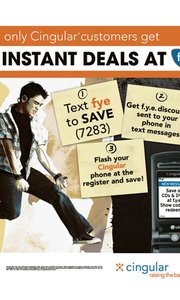Apparel Companies Delve Into Mobile Marketing
Young consumers are like moving targets these days, and tracking them down can be a challenge for apparel marketers. But companies are making inroads by hitting these shoppers where they stand—while they’re on their cell phones.
Retail executives and brand managers have been increasingly upping their stakes in the growing area of demographic. Using SMS (short message service) text messaging and other communications has been an effective way to reach the young consumer, and with technology advancing by the minute, it’s a time to get in or miss the boat, said marketing executives.
Quiksilver, Elizabeth Arden, Foot Locker and juniors retailer Vanity are among the companies already using cellphone marketing.
Unlike Internet e-mail campaigns, cell-phone marketing is not as pervasive as it seems, said Jodi Tollefson, director of marketing for Fargo, N.D.–based retailer Vanity, which has more than 200 stores in 23 states.
“It’s a misnomer that you are intruding upon them, but it’s actually wanted communication,” she said.
In Vanity’s case, the retailer recently ran a promotion in which fans of pop star Fergie could win a chance to meet the singer at any concert venue she’s playing on the globe as well as a $500 Vanity gift certificate by sending a text message to Vanity’s main console. The retailer gathered thousands of new entries and potential customers in its database to be used for text coupons and other promotions.
“It was very successful,” said Tollefson. “It really relates to our girl because they identify with Fergie, who just set out on her own solo career.”
Vanity used the mobile campaign with other bands over the summer and plans to expand its alliance with Fergie later this year.
Huntington Beach, Calif.–based Quiksilver is using mobile marketing in a variety of ways. During the holidays, the surfwear giant ran a mobile coupon campaign called “The Insider Deal” in conjunction with Cingular Wireless. Cingular subscribers text in “QUIK” into their phones and get exclusive offers redeemable at Quiksilver stores. In-store signage and other ads helped alert the customers to the promotion.
Quiksilver is also using mobile technology to send alerts to interested parties about events such as Quiksilver’s Big Wave Invitational surfing contest on the North Shore of Oahu, which takes place when the surf at Waimea Bay hits at least 20 feet. Sign-ups are set up in stores, giving shoppers directions on receiving information via their cell phones on when the surf is up and when the contest is on. Quiksilver in return gets a few thousand leads.
“There’s a trade-off—a value exchange—involved,” said Lon Otremba, president of Culver City, Calif.–based Access 360 Media, which conducted the mobile campaign for Quiksilver and other retailers such as f.y.e. and Mandy.
“Mobile is a key element in everything we do with retailers,” said Lynda Stenge, director of strategic marketing for the Los Angeles offices of Retail Entertainment Design, which coordinated the Fergie campaign for Vanity. “It’s next generation and as key to a campaign as the artist.”
Otremba said mobile marketing is still in its beginning stages but observed a lack of commitment from companies.
“There are some very big retailers that know very little about their customers,” said Otremba. “Five years from now, they’re going to have know who they are or else it’s going to be too late. The customer has the power now, so you better understand what they’re about.”
Texting is only a starting point, noted Otremba, speaking from the recent Consumer Electronics Show in Las Vegas. At the show, Verizon unveiled its V-Net technology with partner Qualcomm, which will allow subscribers to view network television on their units this spring. Apple also recently unveiled its iPhone at the MacWorld conference in San Francisco. The multimedia device, set for June deliveries, features an iPod, a cell phone and Internet service, viewable on a 3-1/2-inch screen.
The growing media capabilities of these “smart phones” will only open up more marketing opportunities,” Otremba added. In fact, companies such as MobiTV, which provides videos to Sprint, Cingular and Alltel subscribers, launched an advertising platform last year that features three minutes of ads in each hour of programming. Cingular has already linked with Mercedes- Benz Fashion Week producer IMG, offering views and news from IMG’s fashion events in New York and Los Angeles.
Silver Springs, Md.–based The Shosteck Group estimates the global market for mobile advertising should reach $9.6 billion by 2010.
Apple’s iPhone will debut in two styles, with price points of $499 and $599. Will those numbers scare off younger consumers?
“It’s a value proposition,” said Otremba. “This demographic embraces new technology. No kid wants to be caught dead with a cell phone that just makes phone calls.”























